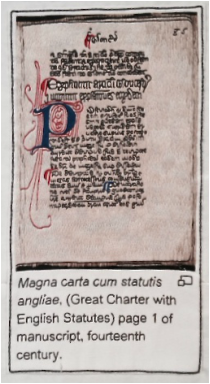lay claim to your rights (economic and moral), who believe that your feet are firmly planted in reality,
at least y-o-u should know that your embroidery work is a documentation of your own era!”
Hannah Hoch, On Embroidery, 1918
Embroidery, on one level a demonstration of feminine skill and domesticity, has a rebellious side as well. Rozsika Parker, in The Subversive Stitch, notes that it has ‘provided a weapon of resistance to the constraints of femininity’. This history of rebellion makes it a fitting medium through which to convey political messages of all types.
This year (next month) marks the 800th anniversary of the Magna Carta, one of the most famous documents ever written. Initially intended as a peace treaty between King John and his barons, the Magna Carta has become a landmark in constitutional history and is considered to be the foundation of the rule of law and a symbol of defence of individual rights and liberties.
| The embroidery is the work of more than 200 individuals, ranging from prisoners working with Fine Cell Work (a social enterprise that trains prisoners in paid, skilled, creative needlework), professional embroiderers, and notables in the fields of civil liberties, justice, equality and information. For Parker, this has echoes of the Bayeaux Tapestry, which also was a communal work of many hands. As explained in the British Library’s press release, each individual stitched words or phrases significant to them. The list ranges from director of Liberty Shami Chakrabarti (stitching ‘Charter of Liberties’) to musician Jarvis Cocker (‘Common People’) to Lord Igor Judge and Lady Judith Judge (‘Habeas Corpus’ – a phrase rejected by one of the many prisoners stitching the embroidery), and from Wikipedia founder Jimmy Wales (‘user’s manual’) to Edward Snowden (‘liberty’). |
Reflecting the importance of the Magna Carta to the US Constitution, the embroidery includes contributions from the US Ambassador to Great Britain and staff at the US Embassy in London, who all embroidered words relating to the US Constitution.
Some contributions are particularly poignant. Former Guantanamo detainee Moazzam Begg has embroidered the words ‘held without charge’. Baroness Doreen Lawrence, mother of Stephen Lawrence, whose murder in 1993 led to a major inquiry about racism in policing, embroidered ‘justice’, ‘denial’ and ‘delay’.
| The piece itself is beautiful, not least for being full of imperfections because of the range of skills used. Parker had the Wikipedia page printed onto fabric, then divided it into 87 sections. The sections were sent around the country to be embroidered by its many contributors, then reunited and sewn together by members of the Royal School of Needlework. Parker says ““I love the idea of taking something digital and making it into an analogue, hand-crafted thing.” Cornelia Parker’s ‘Magna Carta (an embroidery)’ is on display at the British Library until 24 July 2015 (admission free). |



 RSS Feed
RSS Feed
